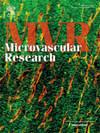Kinetics of thromboxane A2 receptor-driven vascular tone in the cerebral cortex ex vivo
IF 2.7
4区 医学
Q2 PERIPHERAL VASCULAR DISEASE
引用次数: 0
Abstract
Ex vivo imaging in acute cortical brain slices is a valuable tool to assess neurovascular coupling and is particularly useful for studying active, local changes in microvascular compartments in isolation from upstream or downstream changes in flow. However, the lack of vascular perfusion pressure ex vivo results in loss of vascular tone, which must be restored prior to experiments to unmask dilatory signals. The thromboxane A2 receptor agonist U46619 is a widely used preconstrictor, yet its dose-response properties and kinetics of action on different vascular segments are not fully known. Here, we characterize the effects of U46619 on cortical arterioles and capillaries in ex vivo slices from rats and mice. Dose response curves tested in acute rat brain slices using 0 to 1000 nM U46619 showed that maximal constriction is reached at ∼300 nM in both arterioles and capillaries. Extended application of 200 nM U46619 (∼66 % maximal dose) over 2 h revealed that, on average, capillaries constrict faster than arterioles in rat brain slices. Cross-species examination in mouse tissue showed that vessels in mouse brain slices respond faster and constrict stronger on average than in rat brain slices, and that mouse capillaries also constrict faster than mouse arterioles. Our observations suggest that near-maximal preconstriction can be achieved in ex vivo experiments using 200–300 nM U46619, with a minimum incubation time of 20 min for studies involving capillaries and at least 30 min for studies involving arterioles.
体外大脑皮层血栓素A2受体驱动的血管张力动力学
急性脑皮质切片的离体成像是评估神经血管耦合的一种有价值的工具,尤其适用于研究微血管室的局部活动变化,而不受上游或下游血流变化的影响。然而,体外血管灌注压力的缺乏导致血管张力的丧失,必须在实验之前恢复血管张力以揭示扩张信号。血栓素A2受体激动剂U46619是一种广泛使用的预收缩剂,但其剂量反应特性和作用于不同血管段的动力学尚不完全清楚。在这里,我们描述了U46619对大鼠和小鼠离体切片皮质小动脉和毛细血管的影响。使用0 ~ 1000 nM U46619在急性大鼠脑切片中测试的剂量反应曲线显示,在~ 300 nM时,小动脉和毛细血管均达到最大收缩。延长应用200 nM U46619(最大剂量的66%)超过2小时显示,平均而言,大鼠脑切片中的毛细血管收缩速度快于小动脉。在小鼠组织中进行的跨物种检查表明,小鼠脑切片中的血管平均比大鼠脑切片反应更快,收缩更强,小鼠毛细血管收缩也比小鼠小动脉收缩更快。我们的观察表明,在离体实验中,使用200-300 nM的U46619可以实现接近最大的预收缩,涉及毛细血管的研究至少需要20分钟的孵育时间,涉及小动脉的研究至少需要30分钟。
本文章由计算机程序翻译,如有差异,请以英文原文为准。
求助全文
约1分钟内获得全文
求助全文
来源期刊

Microvascular research
医学-外周血管病
CiteScore
6.00
自引率
3.20%
发文量
158
审稿时长
43 days
期刊介绍:
Microvascular Research is dedicated to the dissemination of fundamental information related to the microvascular field. Full-length articles presenting the results of original research and brief communications are featured.
Research Areas include:
• Angiogenesis
• Biochemistry
• Bioengineering
• Biomathematics
• Biophysics
• Cancer
• Circulatory homeostasis
• Comparative physiology
• Drug delivery
• Neuropharmacology
• Microvascular pathology
• Rheology
• Tissue Engineering.
 求助内容:
求助内容: 应助结果提醒方式:
应助结果提醒方式:


